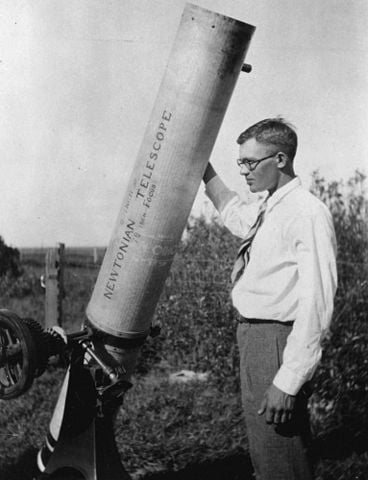Looking over some photographic plates from the month before as part of his research into asteroids, astronomer Clyde Tombaugh noticed a peculiar object on February 18, 1930: the dwarf planet known today as Pluto. Part of a larger cloud of debris called the Kuiper belt, the small orb 4.6 billion miles from the sun has become a controversial figure in the scientific community. Tombaugh came to the Lowell Observatory in Flagstaff, Arizona after demonstrating an expertise in the construction of telescopes, often building his own while passing time on the family farm in central Kansas. After gaining a position as an assistant, he spent much of his days poring over images and observations in search of new objects in the night sky. In 1929, he discovered the first of many asteroids, named 2839 Annette to honor his daughter. (He typically chose names of family members for the different celestial phenomena he found.) Lurking among the distant rocks sprayed across space beyond the orbits of Uranus and Neptune, Percival Lowell — the founder of the observatory Tombaugh worked at — first theorized the presence of a “Planet X” affecting the two outermost planets and predicted its location in 1909. With help from astronomer William H. Pickering, Lowell continued looking for it until his death in 1916, unknowingly catching the two images of the dwarf planet in March 1915. More than a dozen others snapped photos of Pluto as early as 1909, all of them mistaking it for a distant star thanks to its slow movement through the night sky. With Lowell out of the picture, work was delayed for more than a decade while his widow tied up his estate intent on grabbing all she could for herself. Once the proper million-dollar donation was restored, it took a further three years for the search for Planet X to resume, a responsibility which fell to Tombaugh. The 23-year-old diligently spent each day taking photographs of the night sky and looking them over with a blink comparator, an optical device that allows the researcher to quickly flip back and forth between two images. On February 18, 1930, Tombaugh stared deeply at a pair of photos from January 23rd and 29th. There appeared to be a slight deviation. He checked a third, lower-quality print from the 21st. He felt confident his observations confirmed the existence of Lowell’s Planet X. For three more weeks, Tombaugh continued to track the movement of the planet and consulted with other astronomers to verify his results, finally telegraphing his find to the Harvard College Observatory on March 13th. The news shocked the public, resulting in a flood of more than a thousand letters arriving at the Lowell Observatory with ideas for naming the planet. Venetia Burnley, an 11-year-old girl from the English city of Oxford, suggested Pluto. Though many might jump to the conclusion she chose it based on the Disney character Mickey Mouse’s dog, Burnley instead pointed to the Roman name for the Greek god of the underworld, Hades, and correctly assumed Pluto would likely be a cold, dark place — possibly -360 Fahrenheit — like the one described in ancient myth. Taking 248 Earth years to make one pass around the sun, Pluto’s orbit does not fit the regular pattern exhibited by the other eight planets. At times, it is within the path trotted by Neptune, a factor in debates about the true status of the object for decades. Even after the discovery of Pluto’s first moon in 1978, some astronomers were still dubious it could have much the observed effect on the orbits of Uranus and Neptune, the effects which drove Lowell to predict a planet would be there in the first place. Following more than 75 years of being regarded as a planet, the International Astronomical Union announced Pluto no longer fit the bill in August 2006. Citing the shape of its orbit and the various asteroids it shares the Kuiper belt with, experts decided to downgrade it to a dwarf planet. (True planets have to “own” their path around the sun.) Scientific interest still remains high, though. Engineers at NASA launched the New Horizons probe toward Pluto in January 2006, just months before the demotion became official. And, through high-resolution images produced by the Hubble Telescope, astronomers have discovered four additional moons orbiting the dwarf planet, bringing the total to five, the most recent of which being announced in July 2012. Also On This Day: 1846 – The Galician Peasant Revolt begins in what is today western Ukraine 1865 – Forces under the command of General William Tecumseh Sherman set the South Carolina State House on fire in the American Civil War 1913 – Pedro Lascurain becomes President of Mexico for 45 minutes, the shortest term of leadership in history for any nation 1946 – Royal Indian Navy sailors mutiny in Mumbai Harbour, a protest which eventually extends to some 20,000 sailors on 78 ships and in 20 shore locations 1954 – The Church of Scientology is established in Los Angeles You may also like : February 18 1954 – The Church of Scientology is established in Los Angeles
February 18 1930 – Clyde Tombaugh Discovers Pluto
Looking over some photographic plates from the month before as part of his research into asteroids, astronomer Clyde Tombaugh noticed a peculiar object on February 18, 1930: the dwarf planet…
529
